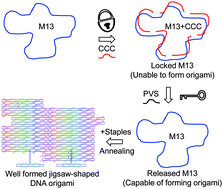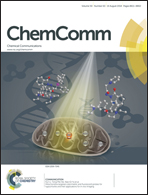A lock-and-key mechanism for the controllable fabrication of DNA origami structures†
Abstract
Controllable fabrication of DNA origami structures was achieved using cationic comb-type copolymers (CCCs) as locks and polyvinyl sulphonic acid (PVS) as a key. A CCC binds to the phosphate backbone of either M13mp18/staples alone or both together and restricts origami folding, while PVS unlocks the CCC, restoring the formation of origami structures.


 Please wait while we load your content...
Please wait while we load your content...